Recently, Panasonic called and asked if I wanted to shoot some more footage with the PX270 now that Iowa had greened up and subjects were more plentiful. But I had something better in mind, a trip back to Yellowstone National Park.
It had been several years since I had been in Yellowstone. Hassles with filming permits kept me out of one of my favorite places to film nature and wildlife. When I saw that the park newspaper stated that a film permit was only needed if I would be using props or actors, I booked my flight and let Panasonic know when I’d be departing.
Unfortunately, a shipping mix up meant that the camera wouldn’t arrive in time so instead of canceling the trip, I packed up my trusty HPX250 and boarded my Delta flight to Bozeman, Montana.
After stopping and visiting some friends, I headed for Yellowstone, timed to arrive just before sunrise.
Chase The Sun And Avoid The Crowds
Past experience has taught me that if you arrive at your filming destination early, you will pretty much have the park to yourself. It was no different this time even thought it was the Fourth of July.
In the Summer, the sun rises in Yellowstone shortly after 5AM. The vast majority of tourists in the park are still fast asleep and will remain so until the light gets too harsh to film.
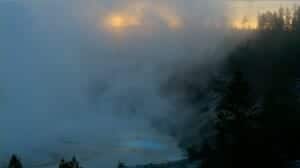
Early morning at Noris Geyser Basin, Yellowstone National Park
So even though the hotels, cabins and campgrounds were full, I had the Noris Geyser Basin all to myself.
I like to arrive before the sun actually rises to give me a chance to get a feel for the location and find my composition before the sun actually illuminates the landscape. Because Noris Geyser Basin is surrounded my mountains, I knew that it would take a little longer for the sun to reach the bottom of Porcelain Basin.
The time before it gets bright enough to film is really my favorite time. It gives me a chance to take in the scene and not have to worry about composition or exposure. It’s a perfect time to take in the peace and serenity.
Work Fast, You Don’t Have Much Time
Once the light comes up I have a short window of time to be able to film as much as possible before the light gets too harsh.
In the Summer, the path of the sun as it rises is almost vertical. By the time the sun clears the mountains in Yellowstone it’s already on the verge of being too harsh to film.
It helps to have a game plan on what you want to shoot but be prepared to abandon it as Yellowstone has so many amazing features it’s almost impossible to stick to the game plan.
I tend to like to shoot into the rising sun and backlight the steam from the geysers. Once the sun gets so bright that it starts blowing everything out, I like to turn around and shoot the geysers, water runoff etc now front lit by the sun
The Silence Is Broken
Usually sometime between 7 and 8 in the morning, you’ll start to hear traffic if you’re close enough to the road. Not too long after that and the tour buses start pulling into the parking lots. Fortunately by that time, I’m usually hiking out back to my vehicle as the light is too hard to give me the looks that I like.
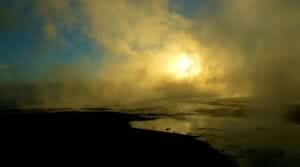
The sun tries to break through at Noris Geyser Basin, Yellowstone National Park
It’s hard to believe that your first shooting setup is done before most people even have breakfast in the morning but I’ve already been shooting for almost two hours.
As I was walking out of Porcelain Basin at Noris, the .6 mile boardwalk loop was literally filled the entire length of the boardwalk as several tour buses unloaded their tourist guests for a few minutes of walking among the geysers.
Even if you’re not finished shooting, the vibration of dozens of people walking on the boardwalks creates so much movement, it’s impossible to shoot any footage.
I really wish I had rolled some footage of the camera being jostled but the tourists as they walked down the boardwalk, I bet it looked like an earthquake was occurring! 🙂
Hard Light Means It’s Time To Scout Your Next Locations
Once the light becomes too hard to film, I often pack up my gear and start scouting for my next location. I have an App on my iPhone that will show me the position of the sun for any time at a location so I can determine what time I need to be there and if it will be a morning or evening shoot to get the best light on the subject.
In Yellowstone it is possible to shoot all day as many areas are in open shade due to the mountains blocking the sun, but I like to spend my mid-day time looking for new places to film.
The tourists are out in full force and if you want to film in a popular place you can pretty much forget about it.
Once I find a spot that I would like to return to, I mark the location with a GPS App on my iPhone. So even when I’m many miles away, I can find that spot again with ease.
Last Call Last Light
As the sun gets lower I start to head to my last destinations of the day.
Certain features in Yellowstone are best filmed in late afternoon light as their orientation keeps them in shade until later in the day.
Oftentimes, my day ends where it began, in the geyser basins. There’s just something about filming billowing steam backlit by the setting sun. I tend to stay out until the light gets too dark to film. Then I pack up my gear and head back to my home base for the night and start the whole process over again.
And as always, shoot the ordinary and make it extraordinary!

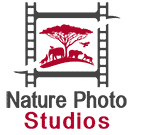
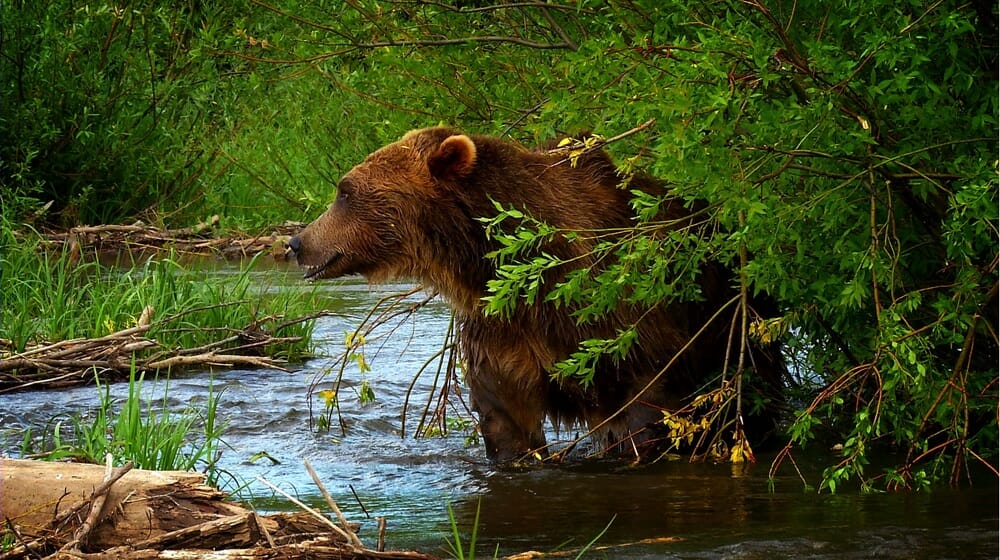

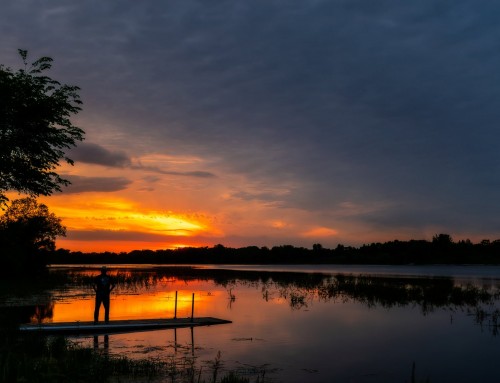
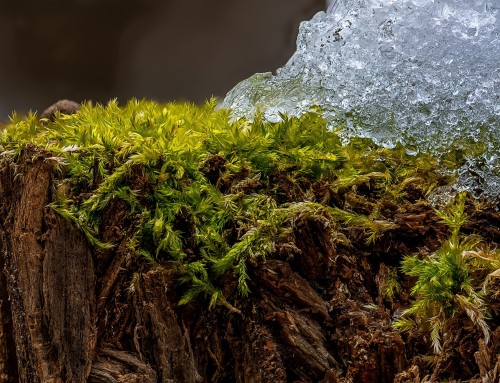


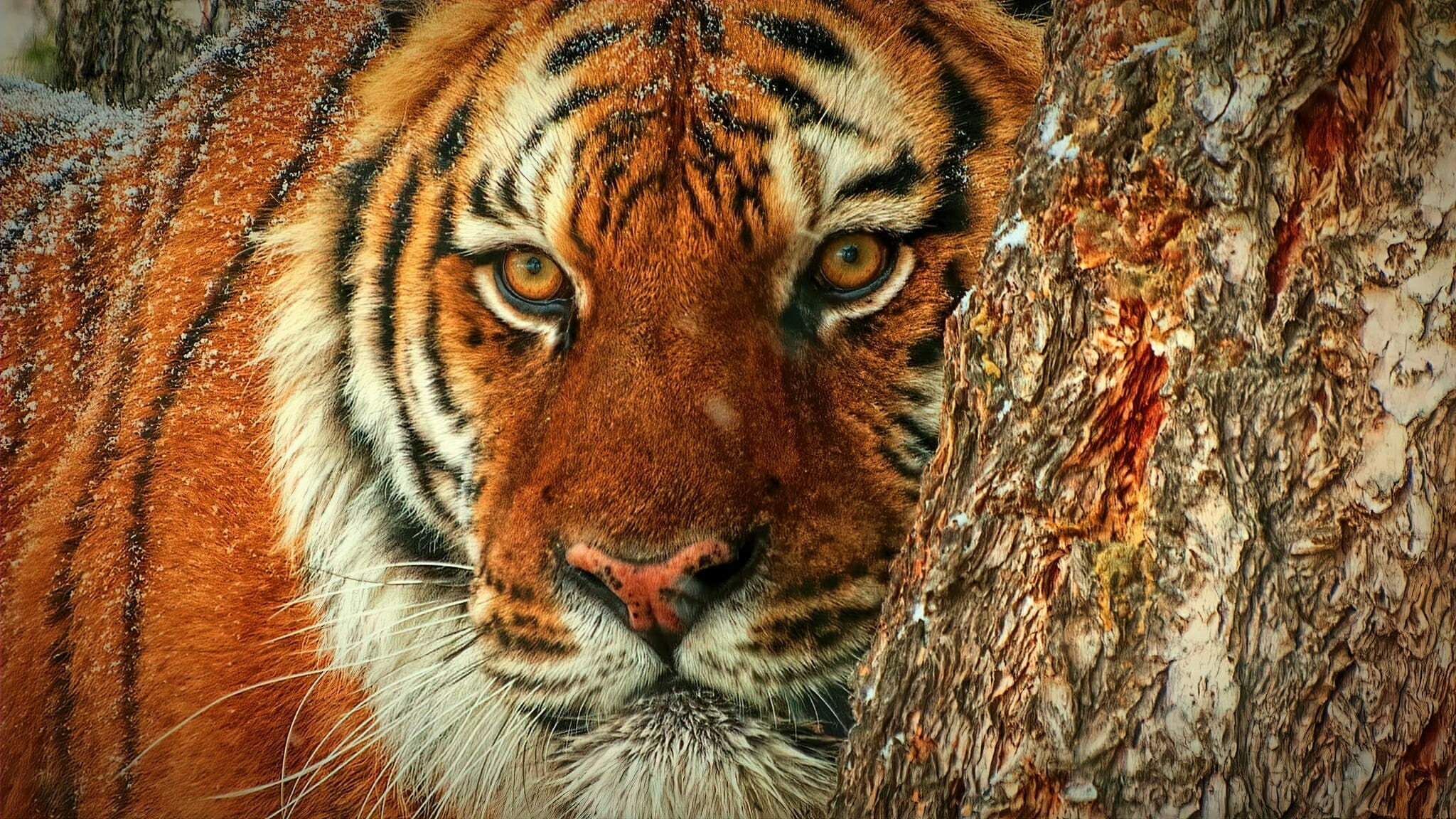
Leave A Comment
You must be logged in to post a comment.